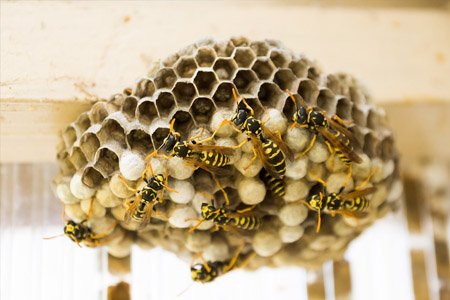
Bees and wasps are an integral component of our ecosystem. Bees help with pollination, while wasps are known for controlling the population of smaller insects and pests. However, both bees and wasps can be harmful to humans and even pets due to their painful stings. This is why a lot of people panic when they come across bees or even wasps. Therefore, if either of these insects is nesting in or around your house, you need to get the nest removed safely by a professional.
Is it a Bee Nest or a Wasp Nest?
If you have noticed a lot of buzzing around your house, you are probably wondering if the unwelcome guests are bees or wasps. Bees and wasps have many similarities and differences in terms of how they live, procreate, and survive to see the next seasons or generation. Nesting is one of the most interesting aspects of their lives.
Wasp nests and bee nests are similar in some ways, but they also have many differences. Being able to differentiate them will help you know the insect that you are dealing with, and therefore the right strategies to be employed in controlling the pests. But how exactly do bee nests differ from wasp nests?

Bee Nests
In most cases, honey bees live in large families in cavities. You can find these social insects in empty tree cavities or even in beehives provided by beekeepers. Honey bees can also choose to live in enclosed spaces, such as the walls of a house. It is also not uncommon to find some solitary bees burrowing in the ground. For instance, bumblebees can build their small colonies in burrows abandoned by rodents.
However, it is worth noting that honey bees do not live in the ground. Their nests are usually identified with the construction material used. Honey bees secrete wax with which they use to build nests to shelter their young ones and store food. In other words, bee nests are made of sheets of honeycombs.
Wasp Nests
Wasps build ground nests, aerial nests, or even nest inside cavities. However, wasps do not secrete any wax, and therefore, their nests are not made of layers of honeycombs. The nests are usually grey in colour, and they are made of a paper-like material, which is basically chewed wood. However, some solitary wasp species, such as the Mud Dauber usually build their wasps using mud.
Conclusion
Overall, it is apparent that although bees and wasps share many similar characteristics, they fundamentally differ in how they build nests. Bees usually secrete wax that they use to create nests that they can use to store food and shelter their young ones. On the other hand, wasps use chewed wood to build nests, and therefore, their nests are paper-like and grey in colour.
But whether you are dealing with wasps or bees in your home, it is imperative for you to remember that both insects are dangerous to the extent that they can sting you, your family, or even your pests. Therefore, if there is a bee nest or a wasp nest on your property, you need to approach it cautiously to avoid provoking these protective creatures. The safest way of dealing with the situation would be to call a pest control professional. If you are looking for an expert to help you get rid of a bee nest or a wasp nest in your West Yorkshire home, Sykes Pest Control is an excellent company to work with. Get in touch with us today for more information about our company and how we can assist you.
Call the Professionals
By the middle of summer, the nest could be the size of a football and house up to 10,000 wasps. At this point, retreat and live to fight another day. Do not approach the nest.
Instead, call the Skyes Pest Control wasp removal technicians, who are fully trained in wasp nest removal. They have the equipment and safety gear to remove the nest safely.
Call Us On
Bradford: 01274 753 170 – Leeds: 01133 229 078 – Mobile: 07796 615260
If you need pest control services in Bradford, Leeds or anywhere in the surrounding 25 mile radius.
